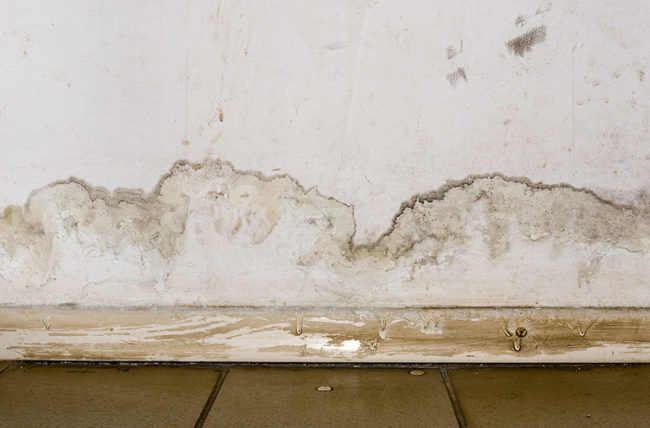
After floods, hurricanes, or other natural disasters, the cleanup phase begins. Owners of facilities, businesses, or homes, maintenance personnel, and others should follow the tips and product recommendations below when grappling with the water damage,
mold growth, contaminated water supply, increased prevalence of disease, and other hazardous conditions that often accompany disasters.
1. Put safety first.
When assessing a building’s condition and repairing damage or otherwise preparing to get back up and running, safety is the single most important consideration. If local officials have indicated that it is safe to return to the area, it is critical
to:
- Wear appropriate personal protective equipment, including:
- Hard hat
- Goggles
- Heavy work gloves (rubber if sewage is present)
- N95 mask or respirator with a higher level of protection
- Waterproof boots with steel toe and insole
- Earplugs or protective headphones (if working with loud equipment)
- Wait until daylight to visit the site, especially if the power is out, so it will be easier to spot and avoid danger.
- Visit the site with a partner, if possible.
- Check for structural damage and downed power lines before entering the building.
- Test major appliances one at a time and don’t use wet or damaged appliances.
- Be wary of:
- Standing water, which could have submerged debris or carry an electrical charge from underground or downed power lines.
- If there is pooled water and you can turn off the electricity without actually standing in the water, then do so. Otherwise, call an electrician.
- Gas leaks
- If a gas leak is suspected, turn off the central valve if possible, leave the area immediately, and contact the utility company, taking care to avoid any actions that could cause a spark.
Stay Informed: Take Clean Further with Betco
Subscribe to Betco emails to join thousands of other industry professionals and get the most helpful blog posts, the latest news, new product notifications, and invitations to our events conveniently in your inbox!
Yes, Sign Me Up!
2. Prioritize removal and prevention of mold.
If standing water has been present in the building for more than 24 hours, it is safe to assume that mold is growing. As continued mold growth in the wake of a natural disaster often proves to be a difficult and long-term problem, it is important
to dry everything and remove all mold as quickly as possible, ideally within 24 to 48 hours.
- If there is no electricity, use a generator to power equipment, but ensure it is at least 20 feet away from the building and is operated with a proper transfer switch or interlock device.
- Use a wet/dry vacuum to remove standing water.
- Product recommendation: Workman® 20 (E83012-00) 20-gallon wet/dry vacuum with powerful 1.75 hp motor for maximum recovery and
multi-task toolkit.
- Remove all soaked materials, including furniture, and dry or discard them.
- Remove mud or silt before it dries.
- Open doors and windows.
- Use fans, dehumidifiers, and similar devices to blow air out of/away from the building and aid in the drying process.
- Check to see if water has seeped into your HCAV system, behind walls, into the building’s insulation, beneath the carpet or floor boards, behind tiles, and similarly “hidden” areas.
- HVAC flooding leads to corrosion, mold growth, and other problems. An affected system will likely need to be entirely replaced.
- Remove and discard drywall and insulation that has been in contact with flood waters.
- Remove and discard carpet that has been flooded with highly contaminated water and/or soaked for more than 48 hours. For salvageable carpet, a hot-water extraction holds the best chance for remediation.
- Product recommendations:
- Fiberpro® 20 (E87303-00)
carpet extractor with 20-gallon solution and recovery tanks, Carpet and Rug Institute certification, and floating vacuum shoe for superior water recovery.
- Fiberpro® 8 (E87304-00)
carpet extractor with 8-gallon solution and recovery tanks, Carpet and Rug Institute certification, and floating vacuum shoe for superior water recovery.
- Fiberpro® ES-Steam™ (402)
for extraction with a highly concentrated formula that quickly penetrates heavy soil and eliminates odors at their source.
- Green Earth® Peroxide Cleaner (336)
as a carpet pre-spray with reduced toxicity and powerful mold removal capabilities.
- Push® (133) with cultured bacteria and malodor counteractants capable of
digesting organic waste for use with or without powered equipment.
- Clean everything with mold on it by using appropriate products according to label directions.
- Fix any leaks as soon as possible.
- For especially intense and/or hazardous cleanup, consult a professional.
3. Prevent disease.
Flood water can contain dangerous pathogens, which is why it is important to safeguard your health and the health of others after a natural disaster.
- Clean and disinfectant all surfaces and objects, even those without visible mold growth.
- Product recommendations:
- Fight Bac™ RTU (311) to kill Hepatitis A in
10 minutes and Hepatitis B, Hepatitis C, and SARS-CoV-2 (the virus that causes COVID-19) in 1 minute.
- GE Fight Bac™ RTU (390) to kill a broad spectrum of disease-causing
pathogens with EPA Design for the Environment approval.
- Wash your hands throughout cleanup or use a hand sanitizer if clean water is not available.
To learn more about any of the products recommended above, click on each. For information regarding specific cleanup procedures, please click here,
sign in or register, then click Betco U to access our training library.